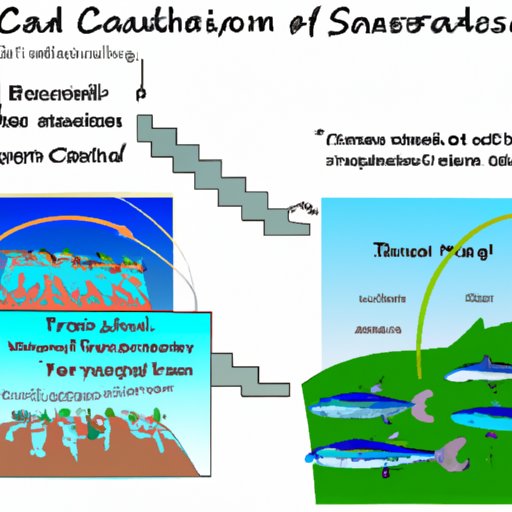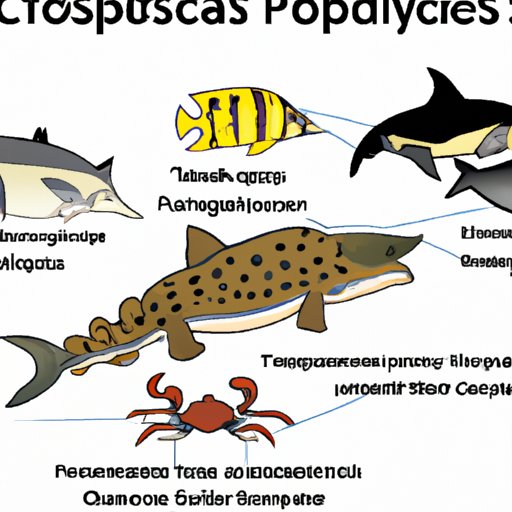Introduction
Understanding the intricate workings of ecosystems is crucial in ensuring their stability and function. Trophic cascades are a key concept in ecology that sheds light on how changes in one species population can have far-reaching effects on the entire ecosystem. This article aims to provide a comprehensive guide to trophic cascades, their different types, and their role in ecosystem functioning.
A Comprehensive Guide to Understanding Trophic Cascades and their Role in Ecosystem Functioning
A trophic cascade refers to the process in which changes to one species population affect the population of other species in an ecosystem. Trophic cascades occur when the addition or removal of a predator triggers a chain reaction that alters the abundances of different species in the ecosystem. This process has been observed across various ecosystems, including terrestrial and aquatic ecosystems.
Types of Trophic Cascades
There are three types of trophic cascades:
- Top-down trophic cascades – occurs when the removal or addition of a top predator impacts the entire food web
- Bottom-up trophic cascades – occurs when changes in primary producers, such as plants, affect the rest of the food web
- Mixed trophic cascades – occurs when both top-down and bottom-up processes interact to influence the food web
Examples of Trophic Cascades in Different Ecosystems
Trophic cascades have been observed in various ecosystems. For example:
- In Yellowstone National Park, the reintroduction of wolves led to a top-down trophic cascade that affected the entire ecosystem. The wolves controlled the population of elk, which in turn allowed the vegetation to recover, and brought back beavers, birds, and other organisms to the area.
- In the oceans, overfishing of sharks has led to a trophic cascade that disrupts the entire food web. The decline of shark populations has caused an increase in the populations of their prey, such as rays and skates, which in turn have had negative impacts on their prey and lower trophic levels of the food web.
Trophic Cascades: How Changes in One Species Population Can Disrupt an Entire Ecosystem
Keystone Species and Trophic Cascades
Keystone species are species that have a disproportionate impact on the ecosystem relative to their abundance. The removal of a keystone species can trigger a trophic cascade. In ecosystems, trophic cascades resulting from the removal of keystone species have been observed to cause significant changes in the community structure and ecosystem processes.
Effects of Trophic Cascades on Ecosystem Stability and Resilience
Trophic cascades can have substantial effects on ecosystem stability and resilience. In most ecosystems, the reduction of predators and keystone species leads to an overall decline in biodiversity and ecosystem function. This can result in changing species interactions and nutrient cycling, which can cause further impacts downstream.
Case Studies of Trophic Cascade Disruptions in Various Ecosystems
Trophic cascade disruptions have been observed in various ecosystems. For example:
- In the Chesapeake Bay, the decline of oysters, which are a keystone species, has resulted in the loss of important ecosystem services and changes in the community structure of the bay. The decline of oysters has led to an increase in the levels of nutrients, which are responsible for harmful algae blooms, reduced water quality, and low dissolved oxygen levels.
- In the African savannah, declines in large herbivore populations, such as elephants and giraffes, can cause a trophic cascade that reduces the density and diversity of trees. This can cause further impacts on the grasses and other organisms that depend on the trees for shelter and food.
Uncovering the Hidden Consequences of Apex Predator Decline through Trophic Cascade Theory
The Role of Apex Predators in Maintaining Ecosystem Balance
Apex predators are top-level predators that have a disproportionately large impact on the ecosystem relative to their abundance. They play a crucial role in maintaining ecosystem balance and biodiversity.
The Effects of Apex Predator Decline on Other Species and Ecosystem Processes
The decline of apex predators can trigger a trophic cascade that affects other species and ecosystem processes. For example, in the case of sharks and other large predatory fish, their decline has led to an increase in the populations of their prey, such as smaller fish and squid, which in turn has resulted in a decline in their prey, such as krill, and lower trophic levels of the food web.
Examples of Apex Predator Decline leading to Trophic Cascades
One example of this is the decline of gray wolves in the Rocky Mountains, which has led to an increase in elk populations. This increase has negatively impacted vegetation, which in turn has led to changes in soil erosion and nutrient cycling. The reintroduction of wolves has helped to reverse this process and restore ecosystem balance.
Exploring the Ecological Impact of Trophic Cascades and the Implications for Conservation Efforts
The Importance of Considering Trophic Cascades in Conservation Planning
The importance of considering trophic cascades in conservation planning cannot be overstated. When managing ecosystems, it is crucial to recognize the impact that changes in the population of one species can have on the entire ecosystem. Trophic cascade theory can help identify areas where conservation efforts should be focused, and predict the potential impacts of species loss.
How Conservation Efforts can be Designed to Prevent or Mitigate Trophic Cascades
Conservation efforts can be designed to prevent or mitigate trophic cascades. For example, when removing invasive species, it is crucial to consider the potential impact on the rest of the food web. Similarly, when reintroducing extirpated species, it is crucial to monitor the potential downstream impacts on other species and ecosystem processes.
Real-world Examples of Conservation Efforts Incorporating Trophic Cascade Considerations
Real-world examples of conservation efforts that consider trophic cascades include the removal of dams to restore habitats and the reintroduction of predators to control prey populations. These efforts have shown positive results in restoring ecosystem balance and function.
The Domino Effect: Trophic Cascades and the Delicate Balance of Natural Systems
Trophic Cascades Demonstrate the Interconnectedness of Ecosystems
Trophic cascades demonstrate the interconnectedness of ecosystems. Each species plays a crucial role in maintaining the balance and function of the ecosystem. When one species is removed or added, it can trigger a chain reaction that has significant impacts on other species and ecosystem processes.
Seemingly Small Changes can have Far-reaching Effects
Seemingly small changes can have far-reaching effects on the entire ecosystem. For example, the decline of bees and other pollinators has led to a decline in plant populations and a reduction in ecosystem services. This decline has negative impacts on everything from food production to air and water quality.
Examples of Trophic Cascades Resulting from Human Activities
Human activities, such as land use change and overfishing, are responsible for many trophic cascade disruptions. For example, deforestation and habitat fragmentation can lead to a decline in apex predators and keystone species that can trigger trophic cascades. Similarly, overfishing of a particular species can lead to a trophic cascade that affects the entire food web in the area.

From Top to Bottom: Understanding the Trophic Cascade and Its Significance in Marine Ecosystems
How Trophic Cascades Operate in Marine Ecosystems
Trophic cascades operate in marine ecosystems similarly to how they operate on land. Changes in the population of one species can affect the entire food web. However, the unique features of marine ecosystems, such as ocean currents and sparse distribution of species, make the effects of trophic cascades more difficult to predict.
The Unique Importance of Keystone Species in Marine Food Webs
Keystone species in marine ecosystems are just as crucial as those in terrestrial ecosystems. For example, the removal of sea otters led to an increase in sea urchin populations, which in turn caused a decline in kelp forests and the organisms that depend on them.
Examples of Trophic Cascade Effects in Marine Ecosystems
Trophic cascade effects in marine ecosystems have been observed in various areas. For example, the overfishing of sharks in the Caribbean led to an increase in the populations of their prey, such as lobsters, which in turn led to a decline in the populations of the lobsters’ prey, such as sea urchins, and lower trophic levels of the food web.
Conclusion
Trophic cascades are an essential concept in ecology that highlights the intricate connections between species and ecosystem balance. Understanding trophic cascades and their effects on ecosystems is crucial in designing effective conservation and management strategies. From terrestrial ecosystems to the ocean depths, trophic cascades impact the functioning of natural systems. It is our responsibility to recognize and consider these impacts to ensure the preservation of biodiversity and ecosystem services worldwide.
